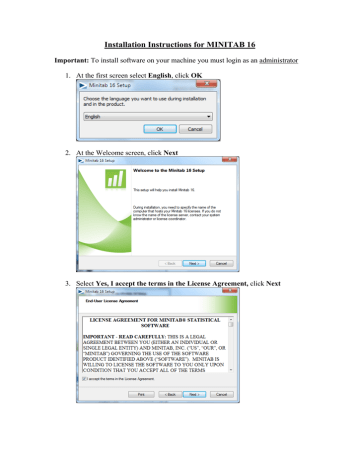


Assumptions #4, #5 and #6 are explained below: However, there are possible solutions to correct such violations (e.g., transforming your data) such that you can still use a one-way ANOVA. In fact, do not be surprised if your data violates one or more of these assumptions. You have to check that your data meets these assumptions because if it does not, the results you get when running a one-way ANOVA might not be valid. If you do not have independence of observations, it is likely you have "related groups", which means you will might need to use a one-way repeated measures ANOVA instead of the one-way ANOVA.Īssumptions #4, #5 and #6 relate to the nature of your data and can be checked using Minitab. For example, there must be different participants in each group with no participant being in more than one group. Assumption #3: You should have independence of observations, which means that there is no relationship between the observations in each group or between the groups themselves.Examples of categorical variables include gender (e.g., two groups: male and female), ethnicity (e.g., three groups: Caucasian, African American and Hispanic), physical activity level (e.g., four groups: sedentary, low, moderate and high), and profession (e.g., five groups: surgeon, doctor, nurse, dentist, therapist). Assumption #2: Your independent variable should consist of two or more categorical, independent (unrelated) groups.If you are unsure whether your dependent variable is continuous (i.e., measured at the interval or ratio level), see our Types of Variable guide. Examples of such dependent variables include height (measured in feet and inches), temperature (measured in ☌), salary (measured in US dollars), revision time (measured in hours), intelligence (measured using IQ score), reaction time (measured in milliseconds), test performance (measured from 0 to 100), sales (measured in number of transactions per month), and so forth. Assumption #1: Your dependent variable should be measured on a continuous level (i.e., it is an interval or ratio variable).Assumptions #1, #2 and #3 are explained below: If these assumptions are not met, there is likely to be a different statistical test that you can use instead. However, you should check whether your study meets these three assumptions before moving on.

You cannot test the first three of these assumptions with Minitab because they relate to your study design and choice of variables.

However, before we introduce you to this procedure, you need to understand the different assumptions that your data must meet in order for a one-way ANOVA to give you a valid result.
#Minitab 16 how to
This "quick start" guide shows you how to carry out a one-way ANOVA using Minitab, as well as how to interpret and report the results from this test. You need to conduct a post hoc test because the one-way ANOVA is an omnibus test statistic and cannot tell you which specific groups were significantly different from each other it only tells you that at least two groups were different. When there is a statistically significant difference between the groups, it is possible to determine which specific groups were significantly different from each other using a post hoc test. Alternately, a one-way ANOVA could be used to understand whether there is a difference in salary based on education level (i.e., your dependent variable would be "salary" and your independent variable would be "education level", which has three groups: "high school", "undergraduate degree" and "graduate degree"). If you have more than one dependent variable, you might need a one-way MANOVA.įor example, you can use a one-way ANOVA to determine whether weight loss is best achieved through exercise, diet, or exercise and diet combined (i.e., your dependent variable would be "weight loss", measured in kilograms, and your independent variable would be "intervention type", which has three groups: "exercise", "diet and "exercise and diet"). However, it is typically only used when you have three or more independent, unrelated groups, since an independent t-test is more commonly used when you have just two groups. The one-way analysis of variance (ANOVA) is used to determine whether the mean of a dependent variable is the same in two or more unrelated, independent groups of an independent variable.


 0 kommentar(er)
0 kommentar(er)
